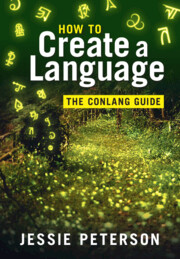Book contents
- How to Create a Language
- Reviews
- How to Create a Language
- Copyright page
- Dedication
- Brief Contents
- Detailed Contents
- Figures
- Tables
- Preface
- Acknowledgments
- Abbreviations
- Part I Building Words
- Part II Constructing Grammar
- Part III Expanding Features
- 13 Word-Formation
- 14 Beyond Basic Clause Structure
- 15 Complex Modifying Forms
- 16 Orthography
- 17 Translation
- Glossary
- References
- Index of Concepts
- Index of Languages
17 - Translation
from Part III - Expanding Features
Published online by Cambridge University Press: aN Invalid Date NaN
- How to Create a Language
- Reviews
- How to Create a Language
- Copyright page
- Dedication
- Brief Contents
- Detailed Contents
- Figures
- Tables
- Preface
- Acknowledgments
- Abbreviations
- Part I Building Words
- Part II Constructing Grammar
- Part III Expanding Features
- 13 Word-Formation
- 14 Beyond Basic Clause Structure
- 15 Complex Modifying Forms
- 16 Orthography
- 17 Translation
- Glossary
- References
- Index of Concepts
- Index of Languages
Summary
This chapter focuses on the art of translation now that you have enough components inyour language to begin using it to express a variety of concepts and ideas. The first section introduces general translation practices, discussing the importance of translating an intended meaning rather than substituting one language’s words for another. The second section provides examples of how you can use translation as an exercise of language expansion, creating new vocabulary and constructions as needed to communicate a particular meaning. At the end of this chapter, you will be asked to translate a short text into your conlang and to write an original text in your language to showcase your language and its features.
Information
- Type
- Chapter
- Information
- How to Create a LanguageThe Conlang Guide, pp. 380 - 394Publisher: Cambridge University PressPrint publication year: 2025
Accessibility standard: Inaccessible, or known limited accessibility
Why this information is here
This section outlines the accessibility features of this content - including support for screen readers, full keyboard navigation and high-contrast display options. This may not be relevant for you.Accessibility Information
Content Navigation
Allows you to navigate directly to chapters, sections, or non‐text items through a linked table of contents, reducing the need for extensive scrolling.
Provides an interactive index, letting you go straight to where a term or subject appears in the text without manual searching.
Reading Order & Textual Equivalents
You will encounter all content (including footnotes, captions, etc.) in a clear, sequential flow, making it easier to follow with assistive tools like screen readers.
You get concise descriptions (for images, charts, or media clips), ensuring you do not miss crucial information when visual or audio elements are not accessible.
Visual Accessibility
You will still understand key ideas or prompts without relying solely on colour, which is especially helpful if you have colour vision deficiencies.
Structural and Technical Features
You gain clarity from ARIA (Accessible Rich Internet Applications) roles and attributes, as they help assistive technologies interpret how each part of the content functions.
